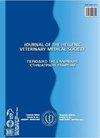上埃及地区马科动物疱疹病毒感染的临床及分子流行病学研究
IF 0.4
4区 农林科学
Q4 VETERINARY SCIENCES
引用次数: 0
摘要
本研究旨在记录马疱疹病毒(EHVs)感染的临床症状,并检测埃及不同省份工作马匹中EHVs感染的流行情况。2018年11月至2019年11月,共对115匹工作马(92匹马和23头驴)进行了临床检查和采样。对每只动物采集2份样本(鼻拭子和血样),采用多重聚合酶链反应(pcr)检测马科动物中不同类型ehv感染的流行情况。在目前的研究中,通过多重pcr检测,埃及马科动物种群中ehv感染的总体流行率为80%。上埃及地区马疱疹病毒感染率最高的是EHV-2型(61.74%),其次是EHV-5型(43.48%)、EHV-1型(20%)和EHV-4型(13.04%)。检出的感染ehv (pcr阳性)的临床体征记录如下:有急性发病史(59.78%)、发热史(57.61%)和/或全身性疾病史(45.65%)、伴有或无呼吸体征(56.52%)和眼部体征(35.87%)的马科动物比例较高。此外,4.35%和1.09%的EHV-1 pcr阳性马出现神经症状和流产。本文章由计算机程序翻译,如有差异,请以英文原文为准。
Clinical and Molecular Epidemiological Study on Herpesviruses Infection among Equid Populations in Upper Egypt
The present study was carried out to record the clinical signs of equine herpesviruses (EHVs) infection and to detect the prevalence of EHVs infection among working equids in different provinces of Egypt. A total number of 115 working equids (92 horses and 23 donkeys) were clinically examined and sampled from November 2018 till November 2019 for this study.
Two samples were collected from each animal (nasal swab and blood sample) and were subjected to multiplex-PCR to detect the prevalence of different EHVs infection among equids.
In the current study, the overall prevalence of EHVs infection among equid populations in Egypt was 80% by using multiplex-PCR. Moreover, the most prevalent equine herpesvirus (EHV) among equids in Upper Egypt was EHV-2 (61.74%), followed by EHV-5 (43.48%), EHV-1 (20%), and EHV-4 (13.04%). The recorded clinical signs of the examined equids harbored EHVs (PCR-positive) can be summarized as follow: a higher percentage was detected among equids with a history of acute onset (59.78%), pyrexia (57.61%), and/or systemic illness (45.65%) with or without respiratory signs (56.52%) and ocular signs (35.87%). Furthermore, 4.35% and 1.09% of EHV-1 PCR-positive equids displayed neurological signs and abortion, respectively.
求助全文
通过发布文献求助,成功后即可免费获取论文全文。
去求助
来源期刊

Journal of the Hellenic Veterinary Medical Society
VETERINARY SCIENCES-
CiteScore
0.60
自引率
0.00%
发文量
83
审稿时长
>12 weeks
期刊介绍:
The Journal of the Hellenic Veterinary Medical Society (J Hellenic Vet Med Soc) is a quarterly peer-reviewed journal that publishes articles in all aspects of veterinary science and related disciplines. It is published by the Hellenic Veterinary Medical Society and is indexed in the Web of Science and in Scopus.
There are no publication fees in the journal. Authors considering submitting manuscripts for evaluation and publication are requested to read carefully the instructions for authors and fully comply with them.
Non-complying manuscripts may be returned to the corresponding author for formatting.
 求助内容:
求助内容: 应助结果提醒方式:
应助结果提醒方式:


